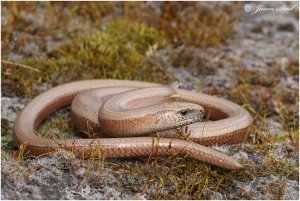For some years now there have been Slow Worms (Anguis fragilis) in my Barnehurst garden , and at some point one or more (the most was 5 at once) turn up in one of the compost heaps. Indeed there were two this morning. So do take care when digging out your bins not to injure one of these beautiful legless Lizards, which are doing you a favour by feasting on Slugs.

You may be lucky enough to have Slow Worms in your garden, and not even realise it …. (Photo: Jason Steel)
The best thing to do is try and find out whether these animals, which are rarely seen in the open, are to be found in your garden. If so, you can then be more careful when managing your heaps. Compost will rot better and faster, especially in the current dry weather, if you can keep some of the moisture in. You can help achieve this by covering with a sheet of plastic – a cut open old sack of commercial compost is ideal. If you put it black side down on top of the rotting material then Slow worms will often congregate under this, and you just have to carefully peel it back to see if they are there. Long grass clippings at the top of the heap will enhance the prospects of seeing one, if they are present.
Alternatively, or in addition, establishing a small heap (that only needs to be about 2 feet x 1 foot x 1 foot tall) in a semi-shaded place – under the overhang of some shrubs is good – and covering that with sacking, is also a good way of finding out whether these animals reside on your property.
In summer it’s best to look on cooler days, in changeable weather or earlier or later in the day as when it’s very hot they will probably be deeper in the heap, though not right down in the fully decomposed material that has a compacted soil consistency.
If you find one Slow Worm with its jaws clamped round the neck of another, leave them to it, as this is mating behaviour. The small gold and jet black young are born in late summer. Adult animals can be told apart by their distinctive head-markings. They can live up to 50 years in captivity.
http://www.arc-trust.org/advice/species-id/reptiles/slow-worm
Bexley is one of the most important Boroughs in London for reptiles, all species of which are in decline and are protected by law, and are UK and London Biodiversity Action Plan targets. The Slow Worm is by far the most widespread of these and, unlike Common Lizard, can survive in garden habitats. It is to be found on slightly less than half the allotment sites in Bexley and a number of other open spaces, but probably occurs in many residential areas unnoticed and unreported. We would be pleased to hear if your Bexley garden is one of them!

I have a number in my greenhouse living beneath the brickwork floor and now a brood in one of my compost bins. Do I have to abandon this heap until next Spring or can these young lizards still safely move to another compost bin before the temperature drops?
It would be best to leave them now. Very exciting that you have them in your garden. Congratulations, you must be doing something right. Jonathan Rooks